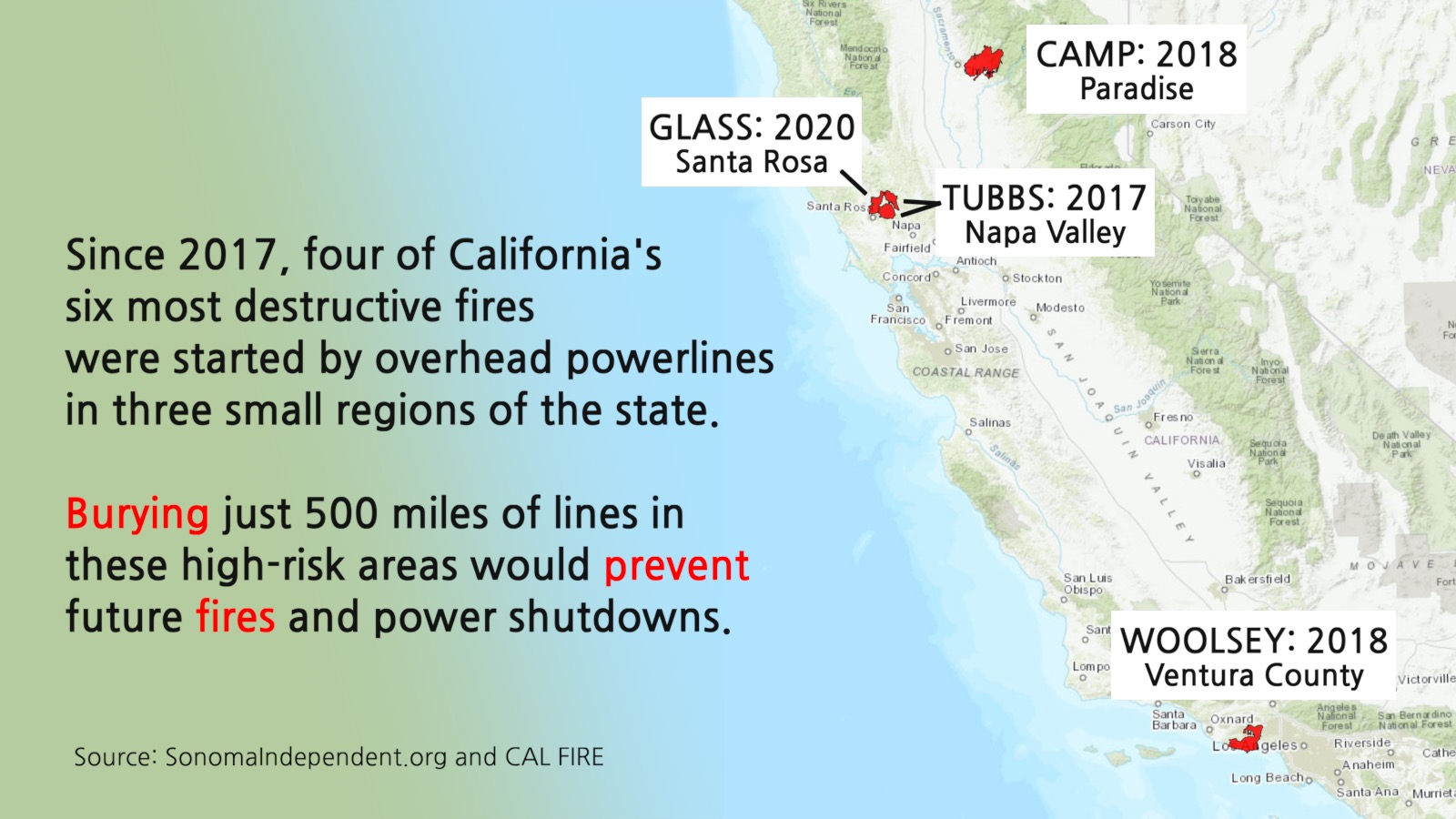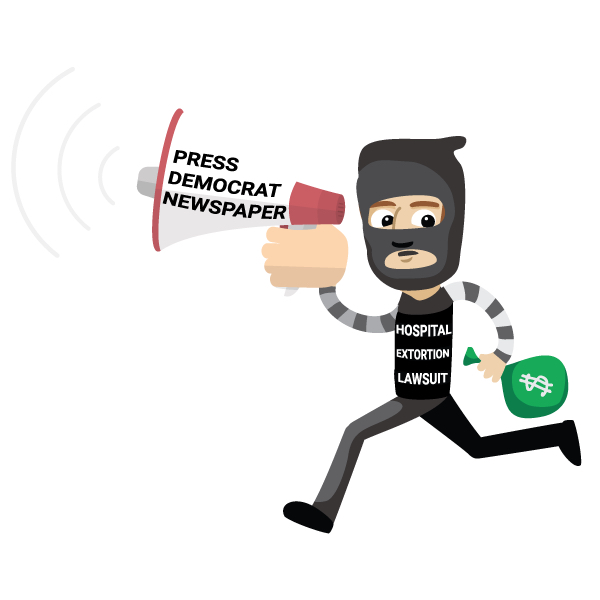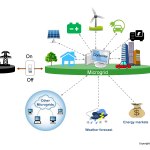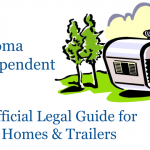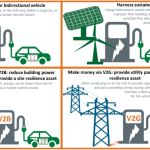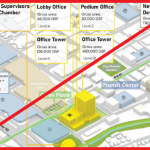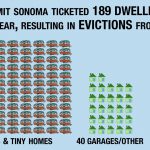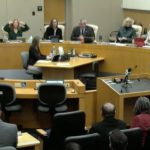Few Californians are aware that our state has the largest budget surplus in history, and that our legislators will decide, by late June, how they will spend $76 billion of our tax dollars.
Yet although $2 billion is being earmarked for fire preparation, remediation and response, not one dollar of this massive surplus is being spent on the single most important thing that our government can do to prevent the catastrophic fires that threaten to make our state uninhabitable: burying the overhead power lines running across a relatively tiny area of dry, windswept countryside.
Meanwhile, ever worsening climate change-driven drought, record heat and high winds conspire to make this year’s fires even worse than 2020, the worst wildfire year ever, in which 4% of our enormous state was burned. Historically dry conditions have already burned five times as much acreage as had been burned this time last year.
This fire season, we can expect massive power shutdowns, hazardous smoke that can take years off our lives, tens of billions in economic damage, thousands of homes destroyed and millions of us displaced due to mandatory evacuations.
What we can’t do, we have been told by our government, is to prevent this from happening.
That’s why the Sonoma Independent has launched a grassroots campaign and petition (please sign it here!) to compel our state legislators to use one third of our unexpected surplus to bury the geographically hazardous overhead power and transmission lines that have caused four of the worst fires in the past four years, including the 2018 Camp Fire (around Paradise), the deadliest and most destructive in California history.
“This is our chance to demand what our politicians have failed to do,” says climate activist Liliana Ma, a UC Santa Barbara student who is the campaign director for Bury Fire-Causing Power Lines Now! “Plan A is spending this budget surplus on something worthwhile for our futures. Plan B is to let our homes burn.”
The Myth That We Can’t Afford It
Californians have been told that “we cannot afford” to bury rural power lines, the way they are buried in Japan, Germany, Sweden and other modern countries, because it is too expensive to do so.
A few years ago, a widely-cited BloombergNEF report estimated that just burying all of PG&E’s 81,000 miles of overhead lines would cost a whopping $240 billion. Which, politicians and experts have told us, is far more money than we can ever afford.
The operative, and deceptive word here is “all.”
Because there is no need to bury all of PG&E overhead power lines in California.
Last year Ephram Glass and his father, Victor Glass, a Rutgers Professor of Professional Practice – Finance and Economics, wrote an important but little known article in T&D World, the journal for the utility industry professionals, in which they dismissed the $240 billion cost estimate. “PG&E’s website page on undergrounding costs could easily mislead someone not familiar with the data,” they wrote. The Glasses found that PG&E vastly inflated the estimated costs of burying power lines in High Fire Threat Districts (HFTD). “Most of the lines in the HFTD areas are rural or suburban lines, not urban. The cost to underground lines in these areas is significantly cheaper than in urban areas because of fewer obstacles and more unpaved rights-of-way.”
The Glasses independent report also slammed PG&E’s web page for stating that the main benefits of undergrounding are aesthetic. “The webpage,” the Glasses observed, “goes on to say underground lines are not immune to weather damage and are vulnerable to equipment issues, lightning strikes, flooding, earthquakes and excavation damage by a third party.” These statements are misleading because the reliability of underground lines is actually far superior to overhead lines.”
“The average outage duration a customer experiences on an underground line in the U.S. is typically more than 90% lower than on an overhead line.”
Most importantly, the Glasses concluded that that only a fraction of PG&E’s overhead lines were in High Fire Threat Districts (HFTD),” and that, over time, “the total cost for burying those lines would likely be closer to $25 billion” which would “nearly eliminate the fire hazard.”
Significantly reducing the threat of fires by removing the low hanging fruit of the highest threat lines, which could easily be prioritized by CAL FIRE based on their tracking of hundreds of past fires, would cost far, far less.
That’s why our petition asks for $1.5 billion and starting in the eight counties with relatively few highly hazardous overhead power lines. According to PG&E, the counties of Butte, Calavaras, Lake, Mendocino, Napa, Nevada, Sonoma and Yuba, which were home to both the Camp and the Tubbs fires (the state’s two deadliest) contain a total of 532 overhead power lines.
This means that for just $1 billion California can, for starters, pay to bury all of the overhead PG&E power lines in the part of the state that created the worst fires in state history, near Paradise and Calistoga.
Another $500 million would pay to bury the highest risk overhead power lines in Ventura County, where fires caused so much smoke that more than 10 million L.A. area residents were advised to stay at home for an entire week.
This $1.5 billion investment could prevent most of the fires in these two regions, as well as all of the costly power shutdowns mass evacuations prompted by high wind conditions that have become tragically routine for Northern California residents.
“Upgrading infrastructure in high-risk areas is an investment that can save the state billions from expensive disaster recovery efforts while supporting communities most vulnerable to climate change impacts,” says Andrew Truman Kim, Chair of California’s Innovation and Sustainability PAC.
Current Rate of Burying Power Lines Will Take More Than 1,000 Years to Complete
California currently has no program to supervise the burying of power lines. Instead we have a public utility regulatory system which effectively forbids regulated utilities like PG&E from burying power lines because they are required, by law, to use the least expensive method of conveying power. Utilities are guaranteed a small profit based on regulated rates, and their capital budgets do not include retrofitting existing power lines to prevent fires.
As a result, because it costs about $800,000 to use overhead transmission lines up to $3 million to bury the power lines, utilities have no choice but to use a far more fire-prone system.
As the Desert Sun reported, “Less than 100 miles per year are transitioned underground, meaning it would take more than 1,000 years to underground all the lines at the current rate.”
This is because, Ephram Glass, an electrical engineer specializing in utility infrastructure told the Sonoma Independent in a recent Zoom interview, utilities are not permitted to factor in the billions of dollars in costs that residents and businesses face when the overhead power lines cause fires. “The consensus is that they must use the lowest cost solution,” he explained. “It’s all about the political will to do the right thing. Because if you bury the lines underground and take all the benefits into consideration, you would recoup the costs relatively quickly, in terms of preventing fires and reducing maintenance.”
Additional benefits: National Security, EV Stations & Rural Broadband
Ephram Glass also points out that burying power lines will have a number of additional benefits. In the age of easily-accessible satellite imagery, homeland security would be greatly enhanced, because with the current system, destroying just one overhead line in a grid system could cut off power to thousands of homes and businesses.
Overhead lines, which are far more vulnerable to trees, wind, ice and birds, are also far more dangerous when they fall during an earthquake. Modern underground wiring has sensors which can tell exactly where any disruption occurs, without requiring much digging.
They can also carry more electricity. President Biden’s infrastructure plan includes spending $15 billion to help pay for 500,000 Electric Vehicle charging stations. Long term funding for replacing overhead lines could attract some of this federal funding to help this important component of transitioning to a post-carbon emissions future.
Delaine Eastin, a former California state assembly member who was the first and only woman to be elected to serve as the state’s Superintendent of Public Instruction, supports using part of the budget surplus funding to help pay to bury power lines and believes that an additional benefit of doing so could be including fiber optic cables in the underground wiring to help bridge the digital divide. “I really believe the children of this state should all be entitled to broadband, regardless of their income. Broadband access should be the right of all children.”
1,500 Union Jobs and 10,000 Low-Skilled Jobs
Handling electrical transmission wires is highly skilled well-paid union work. Spending billions of state surplus funds to prevent fires by burying power lines could employ 1,500 members of the Utility Workers of America Union for the next two years to complete this task, perhaps through a partnership between CAL FIRE, PG&E and SoCal utilities.
The state could also use the effort to bury fire-causing power lines as an opportunity, through CAL FIRE, to employ, train and temporarily house 5,000 homeless Californians and former convicts struggling to re-enter the job market. According to Ephram Glass, for every skilled union worker handling dangerous power lines, burying overhead lines would require three to five workers operating backhoes, digging trenches, directing traffic and tending the job site. $500 million could be used to train and pay 5,000 low-skilled workers $40,000 a year for two years, while they acquire skills that would be useful for infrastructure jobs for the rest of their lives.
Contact Your State Legislators Before June 15
California citizens have until June 15 to impress upon our state legislators and Governor Newsom that we want them to invest just 2%of our surplus windfall in preventing, not just coping with, the devastating epidemic of fires. In addition to signing our petition, the Sonoma Independent urges anyone reading this to email or call your local Assembly and Senate representative: you can easily find their contact info on this state website.
If you are interested in volunteering for, or donating to the Bury Fire-Causing Power Lines Now! Campaign, please contact info@ProgressiveSource.com.
#
About Us
The Bury Fire-Causing Power Lines Now! campaign is a grassroots advocacy effort created by the Sonoma Independent and its parent, the public interest media company Progressive Source Communications. Since its founding in 2015, the Sonoma Independent has won Greater Bay Journalism Awards in each of the past five years as it advocated for issues like the Sonoma County Restore Library Hours Campaign, the Open Our Hospital effort, and the Stop Incarcerating Parents for Victimless Marijuana Crimes petition.
Frequently Asked Questions About This Petition
Q: Do overhead power lines cause fires?
Yes. Overhead power lines have been responsible for the two most destructive fires in California history, the Tubbs fires near Santa Rosa (2017) and the Camp Fire near Paradise (2018), as well as the calamitous Woolsey Fire near Malibu (2018) and Sonoma County’s Glass Fire (2020).
Q: Would the worst fires in California history have happened if the power lines were buried?
No, they would not have happened. Buried power lines are underground, so they never fall down and light dry grass on fire after they are hit by high winds, storms and tree branches flying into them
Q: We can never afford to bury all the overhead power lines, can we?
There is no need to bury all the overhead power lines. Just the most hazardous 500 miles of them, ina relatively tiny area of California. These 500 miles of overhead lines represent just a fraction of 1% of the more than 200,000 miles of overhead lines around the state. We do not need to bury the tens of thousands of miles of densely laid out power lines in cities or suburbs, or the tens of thousands of miles of power lines across the treeless desert, because they do not blow down in high winds and cause fires.
According to PG&E, the counties of Butte, Calavaras, Lake, Mendocino, Napa, Nevada, Sonoma and Yuba, which were home to both the Camp and the Tubbs fires (the state’s two deadliest) contain a total of only 532 overhead power lines. This proposed $1.5 billion appropriation is enough money to bury a total of 500 miles from these areas during the next two years, along with the most hazardous lines around Malibu and Santa Barbara, where windy hills next to dry grassy terrain create similar fire-sparking hazards.
Q: Isn’t California already budgeting enough for fire prevention under the Senate’s Blueprint for a Safe California and Governor Newsom’s increased CAL FIRE budget?
No. Governor Newsom’s recent funding proposal and a package of new bills announced last week by Senator Dodd and six other members of the Senate’s “Wildfire Working Group,” focuses on regulations, preparing for fires by clearing brush to diminish the spread of fires, formulating evacuation plans, making insurance available to farmers and providing the staffing, training and funding to fight fires AFTER they start.
Not a single California tax dollar is being spent on what is by far the most effective way to PREVENT the fires in the first place, which is to bury the fire lines that cause many of them, before they happen.
Q: How would burying the worst power lines impact power shutdowns?
Eliminating overhead lines in fire-prone high wind areas would eliminate the need for PG&E and SCE to preemptively shut down power because of damage-prone rural overhead lines during high winds. These shutdowns, which are happening with increasing frequency, impacted more than 2.5 million Californians last year and are expected to grow this year, which is among the driest and windiest in history.
Q: Would it harm the environment to bury the power lines?
What harms the environment and causes catastrophic carbon emissions are the increasing number of major fires, most of which would have been prevented if the riskiest overhead power loans had been buried. Burying high risk power lines would also end the expanding practice of preemptive power outages, which themselves necessitate the wasting of refrigerated foods and the burning of thousands of tons of carbon from residents forced to relocate. The actual burying of the power lines below the existing overhead lines will disrupt a relatively small amount of land, while permitting trees to grow more freely near where overhead lines necessitate constant trimming.
Q: Why does PG&E need government money to bury overhead lines?
Public utilities like PG&E own the power lines and are responsible for their maintenance. But because their profits are regulated by the state’s Public Utility Regulatory Commission, they are only permitted to budget for the lowest cost of delivering electricity to consumers, regardless of the billions it costs Californians from fires. Because burying power lines can cost four times as much as running lines overhead, PG&E and SCE are not able to pass these costs on to ratepayers, so instead they use the lowest cost method. To avoid liability when their overhead lines cause fires, which they frequently do during high winds, the utility companies preemptively shut down power to increasingly large areas of customers, impacting millions of Californians.
Q: Is this a handout of taxpayer money to PG&E?
This appropriation would not increase profits to PG&E, but it would force PG&E to be part of a solution instead of expanding crippling power shutdowns to avoid liability.
Q: Why shouldn’t PG&E pay part of the cost to bury overhead lines?
They should. That’s why our proposed spending bill, which is being introduced to the Senate and Assembly on June 7, requires utility companies to co-pay $1 for every $2 the state spends to bury overhead lines, and to take that money from their profits instead of increasing rates.
The State’s Public Utility Regulatory commission would oversee the funding to ensure that the allocation did not result in any increased profits for the utilities.
Q: How many jobs would this appropriation create?
During the next two years, PG&E and SCE would use this funding, matched 50% by their own spending, to provide more than 1,500 high-paying union jobs to handle the dangerous line work, Meanwhile, Cal Fire could train and hire more than 5,000 low-skilled workers to help with less skilled but important tasks like operating a back hoe, digging and traffic control.
Q: What happens if legislators do not budget funding to bury overhead lines?
California has a choice: we can stick with the status quo, which means an endless nightmare of destructive wildfires, while allowing PG&E and SCE to expand their pre-emptive power shutdowns for millions of Californians in anticipation of high winds. Or we can fund the burying of 500 of the riskiest miles of overhead lines identified by Cal Fire (based on past fires), and allocate $1.5 billion of new funding from California’s $76 billion budget surplus, alongside $750 million of utility company funding, to pay for it.


